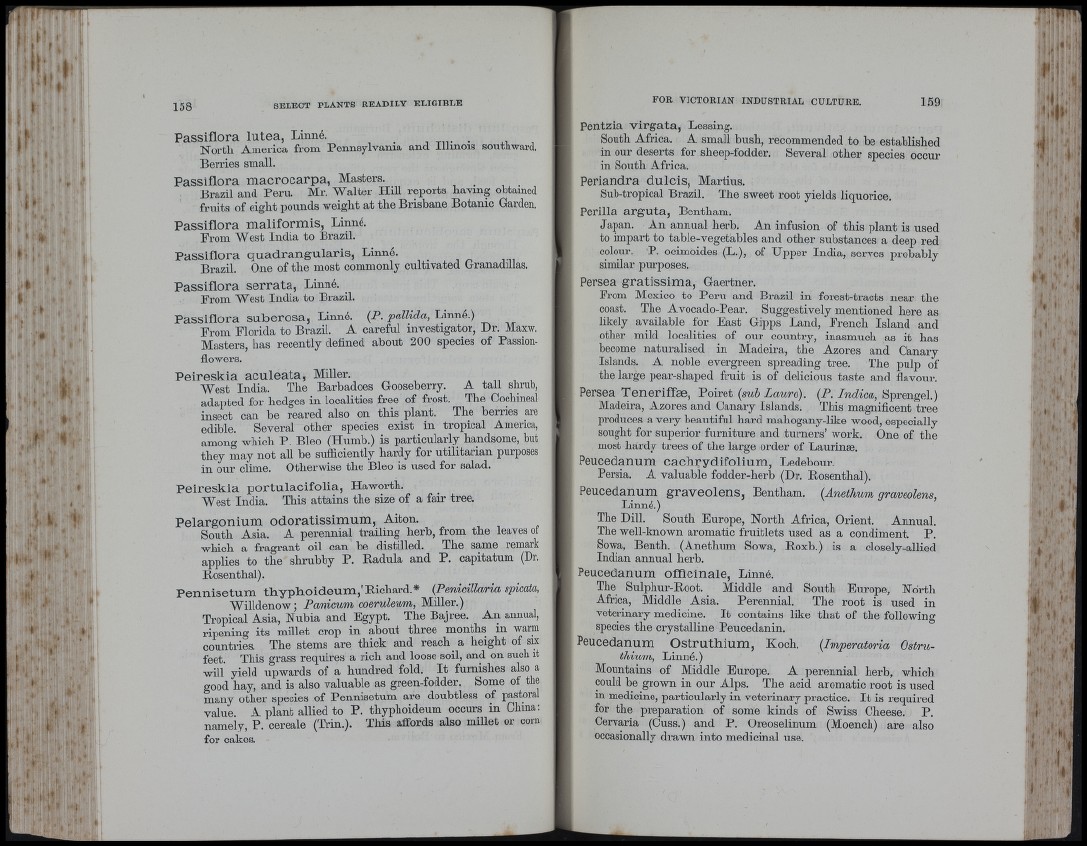
'■ 'H
.1 ! ♦'
c '
158 SELECT PLANTS READILY ELIGIBLE FOR VICTORIAN INDUSTRIAL CULTURE. 159
I*
k. |.
rt
Passiflora lutea, Linné. -, n v • ,
North America from Pennsylvania and lllmois southward.
Berries small.
Passiflora macrocarpa, Masters.
Brazil and Peru. Mr. Walter Hill reports having obtamed
fruits of eight pounds weight at the Brisbane Botanic Garden.
Passiflora maliformis, Linné.
Prom West India to Brazil.
Passiflora quadrangularis, Linné.
Brazil. One of tbe most commonly cultivated Granadillas.
Passiflora serrata, Linné.
Prom West India to Brazil.
Passiflora suberosa, Linné. (F. pallida, Linné.)
From Florida to Brazil. A careful investigator, Dr. Maxw,
Masters, lias recently defined about 200 species of Passionflowers.
Peireskia aculeata. Miller. „ , ,
West India. The Barbadoes Gooseberry. A tall shrub,
adapted for hedges in localities free of frost. The Cochineal
insect can be reared also on this plant. The berries are
edible. Several other species exist in tropical America,
among wbicli P. Bleo (Humb.) is particularly handsome, but
they may not all be sufficiently hardy for utilitarian purposes
in our clime. Otherwise the Bleo is used for salad.
Peireskia portulacifolia, Haworth.
West India. Tbis attains the size of a fair tree.
Pelargonium odoratissimum, Aiton.
South Asia. A perennial trailing herb, from the leaves ot
which a fragrant oil can be distilled. Tbe same remark
applies to the shrubby P. Badula and P. capitatum (Dr.
Rosenthal).
Pennisetum thyphoideum,^Richard.* {Penicillaria spicata,
Willdenow; Panicum coeruleum. Miller.)
Tropical Asia, Nubia and Egypt. The Bajree. An annual,
ripening its millet crop in about three months m warm
countries. The stems are thick and reach _ a height of six
feet. This grass requires a rich and loose soil, and on such it
will yield upwards of a hundred fold. I t furnishes also a
good hay, and is also valuable as green-fodder. Some of the
many other species of Pennisetum are doubtless of pastoral
value. A plant allied to P. tbypboideum occurs in China ;
namely, P. cereale (Trin.). Tliis afi’ords also miUet or corn
for cakes.
Pentzia virgata, Lessing,
South Africa. A small bush, recommended to he established
in our deserts for sheep-fodder. Several other species occur
in South Africa.
Periandra dulcis, Martius.
Sub-tropical Brazil. The sweet root yields liquorice.
Perilla arguta, Bentham.
Japan. An annual herb. An infusion of this plant is used
to impart to table-vegetables and other substances a deep red
colour. P. ocimoides (L.), of Upper India, serves probably
similar purposes.
Persea g r a t is s im a , Gaertner.
From Mexico to Peru and Brazil in forest-tracts near tbe
coast. The Avocado-Pear. Suggestively mentioned here as
likely available for East Gipps Land, French Island and
other mild localities of onr country, inasmuch as it has
become naturalised in Madeira, tbe Azores and Canaxy
Islands. A noble evergreen spreading tree. The pulp of
the large pear-shaped fruit is of delicious taste and flavour.
Persea Teneriffæ, Poiret {suh Lauro). {P. Indica, Sprengel.)
Madeira, Azores and Canary Islands. This magnificent ti'ee
produces a very beautiful hard maliogany-like wood, especially
sought for superior furniture and turners’ work. One of the
most hardy trees of the large order of Laurinæ.
Peucedanum cachrydifolium, Ledebour.
Persia, A valuable fodder-herb (Dr. Rosenthal).
Peucedanum graveolens, Bentham, (Anethum graveolens,
Linné.)
The Dill. South Europe, North Africa, Orient. Annual.
The well-known aromatic fruitlets used as a condiment. P.
Sowa, Benth. (Anethum Sowa, Roxb.) is a closely-allied
Indian annual herb.
Peucedanum officinale, Linné.
The Sulphur-Root. Middle and South Europe, North
Africa, Middle Asia, Perennial. The root is used in
veterinary medicine. I t contains like that of the following
species the crystalline Peucedanin.
Peucedanum Ostruthium, Koch. (Imperatoria Ostru-
thium, Linné.)
Mountains of Middle Europe. A perennial herb, which
could be grown in our Alps. The acid aromatic root is used
in medicine, particularly in veterinary practice. I t is i-equired
for the preparation of some kinds of Swiss Cheese. P.
Cervaria (Cuss.) and P. Oreoselinum (Moench) are also
occasionally drawn into medicinal use.
!
i(i
} I
1 Î